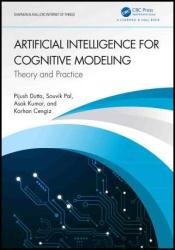Artificial Intelligence for Cognitive Modeling: Theory and Practice
- Добавил: literator
- Дата: 2-03-2023, 01:40
- Комментариев: 0
 Название: Artificial Intelligence for Cognitive Modeling: Theory and Practice
Название: Artificial Intelligence for Cognitive Modeling: Theory and PracticeАвтор: Pijush Dutta, Souvik Pal, Asok Kumar
Издательство: CRC Press
Год: 2023
Страниц: 295
Язык: английский
Формат: pdf (true)
Размер: 26.6 MB
This book is written in a clear and thorough way to cover both the traditional and modern uses of Artificial Intelligence (AI) and soft computing. It gives an in-depth look at mathematical models, algorithms, and real-world problems that are hard to solve in MATLAB. The book is intended to provide a broad and in-depth understanding of fuzzy logic controllers, genetic algorithms, neural networks, and hybrid techniques such as ANFIS and the GA-ANN model.
This book contains 15 chapters altogether. This book is unique for its contents, clarity, precision of presentation, and the overall completeness of its chapters. Understanding logic requires a basic understanding of data structures and C. All the simulation results are obtained from the MATLAB code and SIMULINK. So, this book is useful both for people who are interested in engineering and for research scholars because of what it says and how it says it. This book has a lot of computer simulations that show how different intelligent control techniques were used in real-world case studies. The book is organized into 15 chapters as follows.
Chapter 1 discusses the overview of intelligent systems and soft computing. This demonstrates the scope of their application in real-world problems with complex systems. It highlights the historical development and how it was polarized in different domains. This chapter addresses different software tools that enable decision makers to draw on the knowledge and decision processes of experts in making decisions. Many public accounting firms have put in place some kind of intelligent system to help auditors and make their work more efficient. The most commonly used intelligent systems in public accounting are neural networks, genetic algorithms, and fuzzy logic. Research has led to neural networks that can learn and process datasets roughly, as well as the genetic algorithm for systematic random search and the fuzzy logic controller for roughly estimating reasoning. This chapter also talks briefly about how the book is set up in light of these tools and methods.
Chapter 2 focuses on the practical application of fuzzy logic. Humans and machines differ in that human reasoning is ambiguous, imprecise, and fuzzy, whereas machines and the computers that power them are predicated on binary logic. Fuzzy logic is a technique for increasing the intelligence of machines by giving them the ability to think in a fuzzy style, similar to how humans do. A fuzzy controller is a knowledge-based controller in which fuzzy logic is used to represent knowledge and logical inference. In the present research, the implementation of the fuzzy set and its application in the field of fuzzy logic controllers is described. Beyond these types of membership functions, fuzzification and defuzzification techniques are also described.
Chapter 3 presents a practical approach to neural network models. Biological systems are often compared to intelligent systems when examining how humans carry out control functions or make decisions. Many academics are getting more interested in Deep Learning because intelligent systems are becoming more popular and can adapt to new situations.
Chapter 4 introduces a novel type of classical algorithm for intelligent search and optimization problems that mimics the biological evolutionary process. After a brief introduction to the components of objective functions, objectives, and how to solve any objective function using optimization, different categories of optimization techniques with suitable examples are followed by different steps of Genetic Algorithms (GA) and their application in different domains, depending on the characteristics of the constraints.
Chapter 5 explains in detail the theoretical background of the adaptive neuro-fuzzy inference system (ANFIS) model. Depending upon the learning algorithm, the ANFIS model classification and characteristics are also explained graphically. Finally, overall steps are highlighted to estimate any train and test dataset.
Chapter 6 explores four different types of Machine Learning approaches, including supervised learning, unsupervised learning, reinforcement learning, and inductive logic programming...
Chapter 15 explains how machine learning algorithms are used to collect evaluations from the Internet and classify them into six categories for the prediction of human behavior: walking, going upstairs, walking downstairs, sitting, standing, and laying.
Features:
A detailed description of basic intelligent techniques (fuzzy logic, genetic algorithm and neural network using MATLAB)
A detailed description of the hybrid intelligent technique called the adaptive fuzzy inference technique(ANFIS)
Formulation of the nonlinear model like analysis of ANOVA and response surface methodology
Variety of solved problem on ANOVA and RSM
Case studies of above mentioned intelligent techniques on the different process control systems
This book can be used as a handbook and a guide for students of all engineering disciplines, operational research areas, computer applications, and for various professionals who work in the optimization area.
Скачать Artificial Intelligence for Cognitive Modeling: Theory and Practice
[related-news] [/related-news]
Внимание
Уважаемый посетитель, Вы зашли на сайт как незарегистрированный пользователь.
Мы рекомендуем Вам зарегистрироваться либо войти на сайт под своим именем.
Уважаемый посетитель, Вы зашли на сайт как незарегистрированный пользователь.
Мы рекомендуем Вам зарегистрироваться либо войти на сайт под своим именем.
